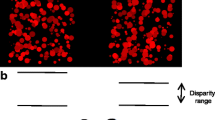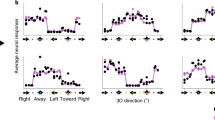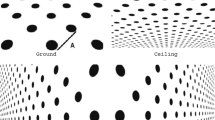Abstract
It is generally expected that depth (distance) is the internal representational primitive that corresponds to much of the perception of 3D. We tested this assumption in monocular surface stimuli that are devoid of distance information (due to orthographic projection and the chosen surface shape, with perspective projection used as a control) and yet are vividly three-dimensional. Slant judgments were found to be in close correspondence with the actual geometric slant of the stimuli; the spatial orientation of the surfaces was perceived accurately. The apparent depth in these stimuli was then tested by superimposing a stereo depth probe over the monocular surface. In both the perspective and orthographic projection the gradient of perceived depth, measured by matching the apparent depth of the stereo probe with that of the monocular surface at a series of locations, was substantial. The experiments demonstrate that in orthographic projection the visual system can compute from local surface orientation a depth quantity that is commensurate with the relative depth derived from stereo disparity. The depth data suggests that, at least in the near field, the zero value for relative depth lies at the same absolute depth as the stereo horopter (locus of zero stereo disparity). Relative to this zero value, the depth-from-slant computation seems to provide an estimate of distance information that is independent of the absolute distance to the surface.
Similar content being viewed by others
References
Chevrier J, Delorme A (1983) Depth perception in Pandora's box and size illusion: evolution and age. Perception 12:177–185
Deregowski J (1970) Hudson's pictures in Pandora's box. J. Cross-Cultural Psychol 1:315–323
Gregory R (1968) Visual illusions. Sci Am 218 (11):66–76
Gregory R (1970) The intelligent eye. Weidenfeld and Nicolson, London
Kennedy JM (1974) A psychology of picture perception. Jossey-Bass, San Francisco
Morrison JD, Whiteside TCD (1984) Binocular cues in the perception of distance of a point source of light. Perception 13:555–566
Ono H, Comerford J (1977) Stereoscopic depth constancy. In: Epstein W (ed) Stability and constancy in visual perception: mechanisms and processes. Wiley, New York
Ritter M (1977) Effect of disparity and viewing distance on perceived depth. Perception and Psychophysics 22:400–407
Ritter M (1979) Perception of depth: processing of simple positional disparity as a function of viewing distance. Percep Psychophys 25:209–214
Stevens KA (1981) The visual interpretation of surface contours. Art Intell 217 (Special Issue on Computer Vision):47–74
Stevens KA (1983a) Slant-tilt: the visual encoding of surface orientation. Biol Cybern 46:183–195
Stevens KA (1983b) The line of curvature constraint and the interpretation of 3-D shape from parallel surface contours. Eighth International Joint Conference on Artificial Intelligence, August, pp 1057–1061
Stevens KA (1983c) Tilt (the direction of surface slant): a neglected psychophysical variable. Percep Psychophys 33:241–250
Stevens KA (1986) Inferring shape from contours across surfaces. In: Pentland AP (ed) From pixels to predicates: recent advances in computational vision. Ablex, Norwood, pp 93–110
Topper DR, Simpson WA (1981) Depth perception in linear and inverse perspective pictures. Perception 10:305–312
Wallach H, Gillam B, Cardillo L (1979) Some consequence of stereoscopic depth constancy. Percep Psychophys 26:235–240
Wallach H, Zuckerman C (1963) The constancy of stereoscopic depth. Am J Psychol 76:404–412
Author information
Authors and Affiliations
Additional information
Supproted by Office of Naval Research Contract N00014-K-84-0533. We gratefully acknowledge the suggestions of Jacob Beck regarding the experimental design, and the assistance provided by Cathryn Stanford
Rights and permissions
About this article
Cite this article
Stevens, K.A., Brookes, A. Probing depth in monocular images. Biol. Cybernetics 56, 355–366 (1987). https://doi.org/10.1007/BF00319515
Received:
Issue Date:
DOI: https://doi.org/10.1007/BF00319515




